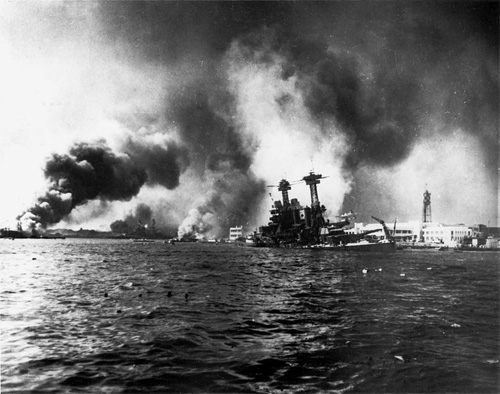The flags at the Embassy and at other American facilities around the world will fly at half mast today in commemoration of National Pearl Harbor Remembrance Day. Since I’m in transit today, what follows is a revised version of my post from December 7, 2011.

The first seconds of the attack on Pearl Harbor, recorded from an enemy fighter.
At 7:55 a.m. on a quiet Sunday morning 71 years ago today, waves of more than 350 hostile fighter, bomber, and torpedo planes darkened the dawn skies over Oahu in a surprise attack designed to cripple America’s defenses and advance a rival power’s aggressive expansion through the Pacific. No declaration of war had been issued.
On the rise and in need of resources to advance its regional objectives, Japan had already invaded Manchuria, China, and French Indochina. It was starting to push into Malaya and the Dutch East Indies to insure control of supplies of oil, minerals, and other resources needed to fuel its ongoing development.

USS Shaw explodes after being struck at the start of the attack.
Tokyo mistakenly believed that the United States would declare war when Japan launched its long-planned invasion of Great Britain’s Southeast Asian colonies. The preemptive attack by a Japanese aircraft carrier strike force on Pearl Harbor, home of the US Pacific fleet, was intended to cripple America’s ability to defend its Pacific neighbors.
While Pearl Harbor was burning, Japanese military forces attacked simultaneously in multiple other locations across the Pacific region. Guam, Wake Island, Manila, and Singapore were bombed. Malaya, Thailand, and the Philippines were invaded. Shanghai was seized. Japanese troops pushed toward Hong Kong and Burma. All the same day.

USS Arizona sinks in Pearl Harbor, taking 1,177 young Americans to their deaths.
In Pearl Harbor that day 2,402 Americans were killed and 1,247 were wounded. On American soil. While the nation was at peace. Eighteen American ships and approximately 340 American aircraft were destroyed or severely damaged.
In Washington, Japanese envoys arrived at the State Department after the attack had begun, to deliver a document from Tokyo criticizing the United States for not accommodating Japan’s demands in ongoing bilateral discussions. A declaration of war by Japan was not delivered until the next day.

USS California sinks in Pearl Harbor.
The morning of December 8th, President Franklin Delano Roosevelt addressed an emergency joint session of the American Congress, beginning with one of the most iconic sentences uttered in American history: “Yesterday, December 7, 1941 — a date which will live in infamy — the United States of America was suddenly and deliberately attacked by naval and air forces of the Empire of Japan.”
The address was broadcast live by radio to the American people. Twenty-one minutes after President Roosevelt finished speaking, the Senate voted 82-0 to declare war on Japan. Twelve minutes later, the House of Representatives concurred by a vote of 388-1. (The lone dissenting vote was cast by Republican Jeannette Rankin of Montana.)

President Roosevelt addresses a joint session of Congress on Dec. 8, 1941.
A strong streak of isolationism has always run through the American psyche, including as war raged elsewhere during 1940 and 1941. The America First Committee and other non-interventionist groups remained strong despite growing anxiety over the hegemonic waves sweeping Europe and East Asia. The Roosevelt Administration had begun taking economic steps to aid beseiged Britain and the Republic of China, but strong majorities of the population and elected officials still opposed entering foreign wars.
The attack on Pearl Harbor changed all that. Americans were shocked — forever, I would argue — out of our belief that the Atlantic and Pacific Oceans provide a safe buffer from the troubles and ills of the rest of the world. In a way that few other events have, Pearl Harbor altered the course of American thinking, history, society, and politics.

Lowering the Embassy flag.
For the next several years we and our friends will commemorate the 70th and 75th anniversaries of the terrible events of that era that shattered societies and changed the world.
Since December 7th last year we at American Mission New Zealand have focused on the joint service, shared sacrifice, and common values that bound Kiwis and Americans so tightly together during the War, and which still provide the bedrock on which our relationship stands today.
We continue the Septuagennial process by planning for several important 2013 commemorations including the 70th anniversary of First Lady Eleanor Roosevelt’s iconic island-hop tour at the height of the Pacific War which brought her to New Zealand for a week.
Today, though, is about remembering Pearl Harbor, honoring those killed that Sunday in 1941, revisiting the lasting lessons learned, and drawing strength from how friends pulled together and persisted through even the darkest of days.
As President Obama noted in his Proclamation, “We pay solemn tribute to America’s sons and daughters who made the ultimate sacrifice at Oahu. As we do, let us also reaffirm that their legacy will always burn bright — whether in the memory of those who knew them, the spirit of service that guides our men and women in uniform today, or the heart of the country they kept strong and free.”

![]()
 RSS
RSS










 View my Profile
View my Profile Connect with Wellington
Connect with Wellington Watch our Videos & Subscribe
Watch our Videos & Subscribe Watch our Videos on Vimeo
Watch our Videos on Vimeo Connect on GPlus
Connect on GPlus US Embassy NZ
US Embassy NZ


 Post Entries (RSS)
Post Entries (RSS)

